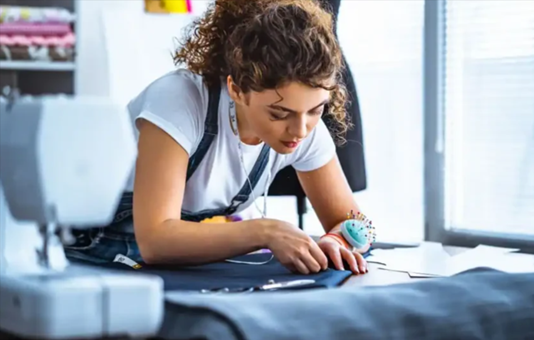Nahttypen When you’re diving into the world of sewing and garment construction, understanding Nahttypen—the German word for seam types—is crucial. Just like a chef needs to know their knives, a seamstress or tailor must understand seams. Let’s walk through everything you need to know about seam types, why they matter, and how to choose the right one for your project.
What Are Nahttypen?
“Nahttypen” simply refers to the different types of seams used in sewing. A seam is where two or more layers of fabric are held together with stitches. While it may sound simple, there’s a surprising variety of seam types, each suited to a specific purpose.
Why Understanding Seam Types Matters
Why bother learning about different seam types? Nahttypen Because the right seam makes or breaks a garment. Nahttypen It affects not only how the piece looks but how it fits, moves, and holds up over time. Imagine wearing jeans where the seams come apart after one wash—no thanks!
Basic Seam Terminology
Before we get technical, let’s get the lingo down.
Seam vs. Stitch
Stitch: The individual loop or connection made by a needle and thread.
Seam: A line of stitches that joins two pieces of fabric.
Common Sewing Vocabulary
Seam allowance: Extra fabric beyond the stitching line.
Topstitching: Decorative or structural stitching on the visible side.
Edge finish: How the edge of the seam is treated to avoid fraying.
Types of Seams (Nahttypen)
Plain Seam
The most basic and widely used seam type. You simply align two pieces of fabric, sew them together, and press the seam open.
Applications
Everyday clothing
Linings
Light to medium fabrics
Pros and Cons
✅ Easy to sew
❌ Not the most durable
French Seam
This seam encloses raw edges, giving a clean, polished look inside and out.
Ideal Fabrics
Lightweight and delicate fabrics like chiffon or silk
Advantages
Neat appearance
Prevents fraying
Flat-Felled Seam
You’ve probably seen this on jeans. Nahttypen One fabric edge is folded over the other, then stitched down.
Common Uses
Denim
Sportswear
Heavy-use garments
Durability
One of the strongest seams
Resistant to fraying
Lapped Seam
One fabric piece overlaps the other, then stitched together, often used in leatherwork.
Aesthetic Appeal
Unique, visible seam
Can be decorative
Bound Seam
This seam uses bias tape to encase raw edges.
Use in Unlined Garments
Jackets, coats, or skirts without lining
Adds a professional finish
Welt Seam
A variation of the flat-felled seam with a more decorative touch.
Decorative and Functional
Adds strength and style
Often seen in tailored suits
Specialized Seam Types
Overlocked Seam
Also known as a serged seam, it trims and finishes raw edges simultaneously.
✅ Fast and efficient
✅ Great for stretch fabrics
Double-Stitched Seam
Two rows of stitches offer extra durability.
Often used in children’s clothes or activewear
Slot Seam
Two fabric edges are turned under and sewn to a strip underneath.
Adds a design detail
Visually interesting
Mock Flat-Felled Seam
Mimics a flat-felled look with less bulk.
Easier for beginners
Used when thickness is an issue
Seam Finishing Techniques
Even after sewing, raw edges need finishing to prevent unraveling.
Zigzag Finish
Done with a zigzag stitch
Quick and easy for home sewists
Serged Finish
Clean and professional
Requires a serger machine
Pinked Edge
Uses pinking shears
Best for fabrics that don’t fray easily
Choosing the Right Seam
Fabric Type Consideration
Lightweight fabrics need delicate seams like French seams. Heavy fabrics benefit from flat-felled or double-stitched seams.
Purpose of Garment
Is the garment casual or formal? Will it undergo stress (e.g., activewear)? Your seam should reflect its use.
Aesthetic vs Functionality
Sometimes, you need both beauty and strength. Bound and welt seams can give you the best of both worlds.
Common Mistakes in Seaming
Poor Tension: Can lead to puckering or loose seams
Wrong Seam for Fabric: Heavy fabrics need sturdy seams
Ignoring Seam Allowance: Leads to poor fit and finish
Seam Types in Fashion Design
High Fashion vs Ready-to-Wear
High-end designs often use French, bound, or welt seams for a clean finish. Fast fashion sticks to simpler seams for speed and cost-effectiveness.
Visual Impact
Seams can shape a silhouette, draw the eye, and add texture. Designers use seam types intentionally for these effects.
Conclusion
So there you have it—a deep dive into the world of Nahttypen. Whether you’re sewing at home or dreaming up your next fashion masterpiece, knowing your seam types helps you choose the right one for the job. It’s the foundation of strong, stylish, and long-lasting garments. Take the time to master these, and your projects will thank you.
FAQs
1. What is the strongest seam type?
The flat-felled seam is generally the strongest due to its double stitching and enclosed raw edges.
2. Can all seam types be used on any fabric?
No. Seam choice should depend on fabric weight and texture. For example, French seams are ideal for lightweight fabrics.
3. What’s the difference between a seam and a stitch?
A stitch is a single loop of thread; a seam is a line of stitches joining fabrics.
4. How can I make my seams more durable?
Use appropriate seam types, maintain good thread tension, and finish raw edges properly.
5. Which seam is best for beginners?
Plain seams and mock flat-felled seams are beginner-friendly and easy to master.
